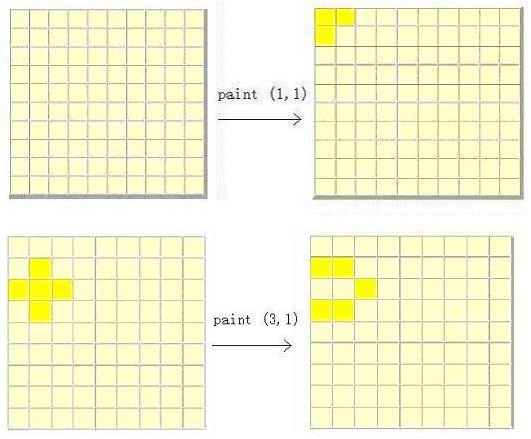POJ 1681 Painter's Problem(高斯消元)
Posted ITAK
tags:
篇首语:本文由小常识网(cha138.com)小编为大家整理,主要介绍了POJ 1681 Painter's Problem(高斯消元)相关的知识,希望对你有一定的参考价值。
| Time Limit: 1000MS | Memory Limit: 10000K | |
| Total Submissions: 5585 | Accepted: 2697 |
Description

Input
Output
Sample Input
2
3
yyy
yyy
yyy
5
wwwww
wwwww
wwwww
wwwww
wwwww
Sample Output
0
15
Source
题目大意:
一个n*n 的方格 ,我们对它进行染色,每个格子都 可以 染成 白色和黄色,( 一旦我们对这个格子染色 ,他的上下左右 都将改变颜色);给定一个初始状态 , 求将 所有的 格子 染成黄色 最少需要染几次? 若 不能 染成 输出 "inf"
解题思路:
我们可以首先来构造一个矩阵,这个矩阵式干啥的呢,我们可以认为这个矩阵是按下一个格子之后它能够作用的范围,将能够作用的范围用1表示否则用0表示。来举个例子
就 根据一个3*3的矩阵,对于第一行第一列的元素来说,它可以影响的范围是它自己 还有它的右面的值和它的下面的值,矩阵中其余的值都是0,也就是说
A(0,0)=
1 1 0
1 0 0
0 0 0
A(0,1)=
1 1 1
1 0 0
0 0 0
现在我们设一个L矩阵,表示初始的状态,如果是y就是0,否则就是1,也就是说我们需要将当前的矩阵操为全是0的矩阵
L
+ x(1,1)*A(1,1) + x(1,2)*A(1,2) + x(1,3)*A(1,3) + x(2,1)*A(2,1) + ... + x(3,3)*A(3,3) = 0 (1)
上述 方程的 x 表示的是一个未知数,因为我们不知道是否是按下这个按钮。那么x(i, j)=0表示不按,否则表示按。那么我们现在就是求一个这样的方程解最小的x,那么上述方程中的矩阵A可以用一个比较大 的矩阵n*n的来表示,然后就是转换一下关系就行了(具体在代码中有体现)。那么现在就是n个未知数,n个方程,在(1)中,可以两边加上L,那么就是变成了:
x(1,1)*A(1,1) + x(1,2)*A(1,2) + x(1,3)*A(1,3) + x(2,1)*A(2,1) + ... + x(3,3)*A(3,3) = L(2)
X * A = L(类似这样的)
然后我们在枚举一下所有的状态:我们首先要枚举的是自由变元的个数,我们对它的所有状态都进行枚举,然后得到了如果符合状态的话就进行自由变元的赋值,然后我们在对可以确定的变元进行操作,那么肯定就是高斯中的回代过程,然后在进行判断,我们需要的就是最少的1,也就是最少能够操作的数。
具体还得详见代码:
My Code:
<span style="font-size:18px;">#include <iostream> #include <cstdio> #include <cstring> #include <cstdlib> #include <cmath> using namespace std; const int MAXN = 3e2+5; const int INF = 1e9+5; int equ, var;///equ个方程 var个变量 int a[MAXN][MAXN];///增广矩阵 int x[MAXN];///解的数目 bool free_x[MAXN];///判断是不是自由变元 int free_xx[MAXN]; int free_num;///自由变元的个数 inline int GCD(int m, int n) { if(n == 0) return m; return GCD(n, m%n); } inline int LCM(int a, int b) { return a/GCD(a,b)*b; } int n; int Gauss() { int Max_r;///当前列绝对值最大的存在的行 ///col:处理当前的列 int row = 0; int cnt = 0;///自由变元的编号 for(int col=0; row<equ&&col<var; row++,col++) { Max_r = row; for(int i=row+1; i<equ; i++)///找当前列中最大的行 if(abs(a[i][col]) > abs(a[Max_r][col])) Max_r = i; ///交换Max_r行 与 当前行 if(Max_r != row) for(int i=0; i<var+1; i++) swap(a[row][i], a[Max_r][i]); if(a[row][col] == 0) { row--; free_xx[cnt++] = col;///后面的 continue; } for(int i=row+1; i<equ; i++) { if(a[i][col]) { for(int j=col; j<var+1; j++) a[i][j] ^= a[row][j]; } } } for(int i=row; i<equ; i++) if(a[i][var]) return -1;///无解 return var - row;///自由变元的个数 } int Solve(int S) { int s = (1<<S);///所有的状态 int ans = INF; for(int i=0; i<s; i++)///枚举状态 { int cnt = 0; memset(x, 0, sizeof(x)); for(int j=0; j<S; j++) { if(i & (1<<j)) { cnt++;///1的个数,也就是能够操作的个数 x[free_xx[j]] = 1; } } for(int j=var-S-1; j>=0; j--) { int tmp = a[j][var], tp, ok = 1; for(int k=j; k<var; k++) { if(a[j][k] && ok) { tp = k; ok = 0; } if(a[j][k] && k!=j) tmp ^= x[k]; } x[tp] = tmp; cnt += x[tp]; } ans = min(ans, cnt);///最少的操作数 } return ans; } int main() { int T; cin>>T; while(T--) { cin>>n; equ = var = n*n; memset(a, 0, sizeof(a)); for(int i=0; i<var; i++) { int ta = i%n, tb = i/n; a[i][i] = 1; if(ta > 0) a[i][i-1] = 1; if(ta < n-1) a[i][i+1] = 1; if(tb > 0) a[i][i-n] = 1; if(tb < n-1) a[i][i+n] = 1; } for(int i=0; i<n; i++) { for(int j=0; j<n; j++) { char ch; cin>>ch; if(ch == 'y') a[i*n+j][var] = 0; else a[i*n+j][var] = 1; } } int S = Gauss(); if(S == -1) puts("inf"); else cout<<Solve(S)<<endl; } return 0; }</span>
以上是关于POJ 1681 Painter's Problem(高斯消元)的主要内容,如果未能解决你的问题,请参考以下文章